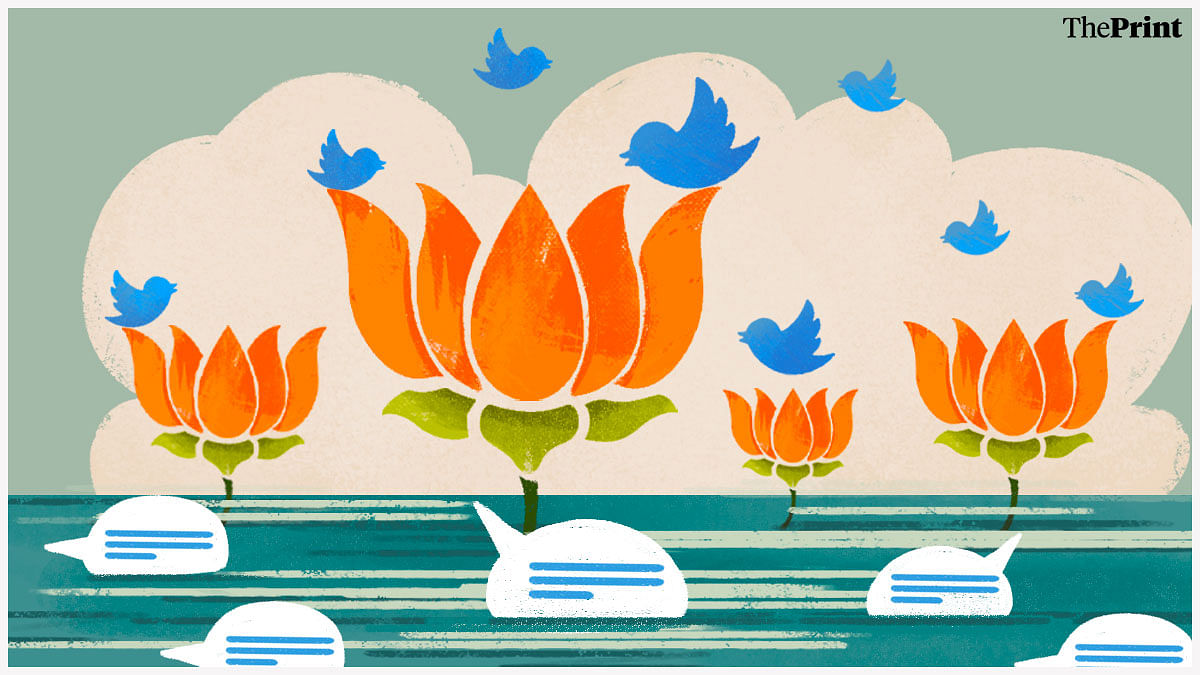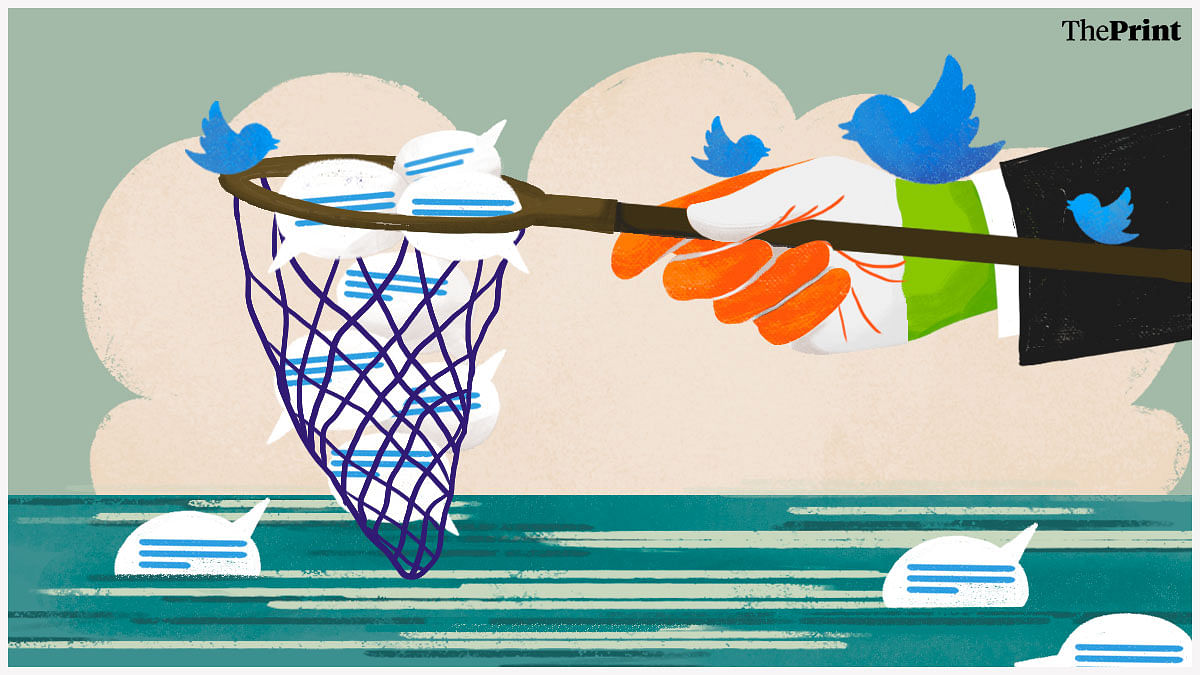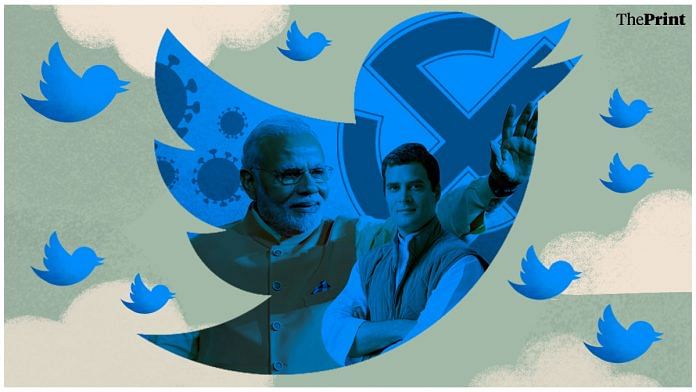New Delhi: In terms of pure popularity, Twitter is a bit of a laggard in India when compared to WhatsApp, YouTube, Facebook, and even Instagram, according to data released by the government earlier this year. However, when it comes to politics, there is little doubt that Twitter punches far above its weight.
While the credit for Twitter’s disproportionate influence in India can be attributed in great part to its strategic adoption by Prime Minister Narendra Modi and crores of BJP supporters, the platform has also increasingly helped the Congress amplify its reach.
The reason why Twitter matters so much — despite having 1.75 crore users compared to WhatsApp’s 53 crore, and earning 18 times less than Facebook in India — is because it has emerged as the platform that most influences what the rich, the political class, and even journalists see, think, and share.
You dominate what these influential people see, the idea goes, you dominate what the masses are going to see.
Also Read: Modi now has over 70mn Twitter followers, BJP says he is ‘most followed head of state’ in world
The big Modi boost
Prime Minister Narendra Modi is not only the most followed Indian on Twitter (with 7.3 crore followers as of Sunday evening), he is also a major reason for the platform’s growth in India.
Indeed, Modi saw the importance of Twitter well before even the BJP’s IT experts did.
Prodyut Bora, the first IT cell head of the BJP (he has since resigned from the party), told ThePrint that during his stint between 2007 and 2009, Twitter was barely factored into the party’s digital strategy.
“No one would have thought back then that Twitter or any social media could impact social harmony or electoral processes as much as they do today,” he said, adding that, in this period, the IT cell did not even set up Twitter accounts for Modi or other BJP leaders.
Modi, meanwhile, had wised up to the benefits of Twitter when he was still chief minister of Gujarat. In January 2009, he became one of the earliest Indian politicians to join Twitter; his Facebook page started several months later in May 2009.
Vikas Pandey, a trained software engineer who since 2002 has set up several pro-Hindu-Right-wing online groups (with names like “RSS” and “Hinduism”) and worked as a volunteer for the party’s online campaign in 2014, praised Modi’s “foresight”.
“Modi ji is a visionary, miles ahead of others. He understood what social media can do in an election,” Pandey, who also volunteered for the BJP’s 2014 campaign, told ThePrint. “I didn’t see how Twitter was more special than other platforms for the longest time,” he added.
When the BJP came to power in 2014, Modi continued to use Twitter as his de facto platform to communicate with the public. With the PM’s blessings, other ministers and government departments also started getting on Twitter.
In June 2014, Raheel Khursheed, the then Twitter head of news partnerships, wrote with some exhilaration about the PM’s “Twitter-First” strategy, pointing out that within one month, Twitter had emerged as “the key platform to keep track of what the government is busy with: the PM has been using his personal handle (@narendramodi), complimented [sic] by his office’s official handle (@PMOIndia), to share updates”.
He further noted the PM’s cabinet was “flocking” to Twitter, with “nearly 40 ministers and ministries already sharing daily updates with their followers”.
This happy relationship with the platform went a step further in 2016 with Twitter Seva, a feature made with the Indian government in mind.
Twitter executives like Khursheed promoted it as “a customised e-governance delivery service” that would increase the Twitter outreach of various ministries and make it easier and faster to address citizen queries and complaints than traditional systems.
Twitter Seva effectively meant the government under Modi could perform its basic job of being accountable to the public via Twitter.
However, Twitter was never just about straightforward communication.

A virtual battleground
The beauty of Twitter’s algorithm is that an ordinary person’s tweets can be as visible as those of the rich, famous, and powerful. When you comment on someone’s tweet, your views will show up in the Twitter feeds of others too. Recognising this, BJP supporters organised themselves to use this feature to counter contradicting views.
Twitter was a contentious space even more than a decade ago.
In January 2010, four years before the BJP came to power, journalist Sagarika Ghose tweeted that “Internet Hindus” were like “swarms of bees” who attacked “at any mention of Modi Muslims or Pakistan”.
Internet Hindus are like swarms of bees. they come swarming after you at any mention of Modi Muslims or Pakistan!
— Sagarika Ghose (@sagarikaghose) January 24, 2010
That comment caused a flutter. “Right wing supporters in general were furious with that comment,” Vikas Pandey said. Two years later, it was still giving fodder to TV debates.
Giving us a brand name "Internet Hindus" was the biggest mistake @sagarikaghose did in her journalistic career. She organized us
— Internet Hindu (@Internet_Hindus) November 11, 2012
The ability to speak truth to power, or challenge a relatively powerful or influential person this way highlighted the potential potency of tweets.
Congress leader Shashi Tharoor knows all about it. In 2009, he faced backlash from his own party when he referred to the economy section of a flight as the “cattle class”. Then, in 2010, the Congress asked him to resign as the minister of state for external affairs when cricket IPL founder Lalit Modi tweeted that Tharoor was linked to alleged irregularities in a franchise.
Tharoor told ThePrint that using Twitter has been a mixed bag. “You gain some, you lose some. Certainly, there is no doubt that I did lose some with a number of controversies being stirred up by my tweets, often maliciously,” he said.
According to Tharoor, his experiences on Twitter served as something of a cautionary tale for other Congress leaders, who at first kept their distance from the platform.
“The controversies in which I was embedded was the reason that many backed away. Initially, when I hit 10,000 followers and people started to take notice, extremely senior people in the party and in the [Congress] government [wanted to know] how to tweet. But the moment everything became controversial, they shied away,” Tharoor said.
However, the Congress has followed in the BJP’s footsteps since and has, of late, covered a lot of ground on Twitter.
Also Read: Follow our law or quit India — Time for Twitter to stop behaving like an internet coloniser
Congress goes big on Twitter too
Despite its late start, the Congress has been revamping its online strategy, and in-house analytics are believed to have shown promising results.
Rohan Gupta, the social media head of the Congress, told ThePrint that the main Twitter handle of the Congress “gets 50 per cent more engagement compared to BJP’s main Twitter account”.
Shivam Shankar Singh, the author of The Art of Conjuring Alternate Realities and How to Win an Indian Election, worked as a data analyst for the BJP for two years (he resigned in 2018). According to him too, the Congress has seen an uptick in its Twitter influence, especially during the pandemic.

“By 2020, especially during the Covid lockdown, the Congress had emerged as dominant as the BJP in how many [Twitter] users see their message. During the second wave this year, the Congress had bypassed the BJP and emerged as the party making the best use of Twitter. The Youth Congress was actively seen helping people and aiding Covid relief efforts via Twitter,” Singh told ThePrint.
A study of SOS tweets this April, conducted by the digital forensic research lab of the Washington-based think tank Atlantic Council, showed that the most frequently tagged account in tweets asking for help during the Covid second wave was that of Youth Congress chief Srinivas B.V. No BJP leader made it even to the top five sought-after accounts.
However, this may not be an accurate barometer of the Congress’s political influence and internet popularity.
The BJP’s digital machinery and reach is formidable, and more people on the ground seem to identify with its ideology than that of the Congress.
The BJP also leveraged online engagement with top celebrities, including Amitabh Bachchan and Sachin Tendulkar, to increase its visibility, according to a study by an associate professor at the University of Michigan, who examined over 9,000 tweets from @narendramodi between February 2009 and October 2015 to research the PM’s engagement with Indian public figures pre- and post-elections.
Not just that, the Congress still lags way behind on WhatsApp, India’s most used quasi-social media platform, where the BJP famously makes thousands of groups with hyper-local messages to reach voters.
A cursory search online shows a plethora of links to join WhatsApp groups with names like “Narendra Modi Fans Group” and “Modi ke bhakts group”. Sangh affiliates also have a strong presence — a purported site for Bajrang Dal, for example, shows WhatsApp group links to join state-level groups of the outfit.
The BJP and allied organisations are also tapping into newer platforms. For example, BJP leader Kapil Mishra has a ‘channel’ called ‘Hindu Ecosystem’ with over 18,000 members on the messaging platform Telegram. On the audio chat platform Clubhouse, Mishra also hosts sessions with other BJP leaders like Tajinder Pal Singh Bagga.
On Facebook, members of the Sangh Parivar, including the BJP’s ideological fountainhead Rashtriya Swayamsevak Sangh (RSS) and the Vishva Hindu Parishad (VHP), have legions of followers.
Nonetheless, despite the BJP’s focus on reaching the masses through messaging apps like WhatsApp, Telegram, and other platforms, Twitter remains essential to influencing the elite, who then go on to influence others.
Setting the narrative for journalists
The main game on Twitter for the BJP has been all about narrative, narrative, narrative.
Arvind Gupta, the IT cell head of the BJP during the decisive 2014 elections, told ThePrint that social media was one of the factors “impacting about 160 seats”.
He explained that Twitter affects election outcomes because it “can impact swing voters and set the narrative”, and should therefore be a “medium of outreach” during election campaigns.
Amresh K, a former BJP IT cell state convenor and national co-convener, threw further light on Twitter’s usefulness ahead of polls.
“Around 2012, Arun Jaitley ji met me in Mumbai and asked us to focus more on what can be done with Twitter in election campaigning… Twitter became important to us because of how it can push messages to people that don’t even follow your account,” Amresh told ThePrint.
He added that, at first, the party pushed content on Twitter just to test what worked, and soon realised just how powerful the results could be with the right kinds of strategies. “What we found was that hashtags can be pushed and we could trend things by getting volunteers to tweet the messages. It let us amplify messages like no other tool allowed us to,” Amresh said.
Twitter has a “trending” section that displays the top 30 hashtags and keywords. To make it to the top 30, a topic needs to have a large number of tweets using the same keyword, and it needs to be happening in real time.
Journalists who are on Twitter often decide what is newsworthy based on the top few trending hashtags or keywords. Therefore, it became the goal of political IT cells to tweet enough on a particular topic to make the Twitter algorithms rank it as the number 1 trending topic.
Many journalists are also fond of Twitter because it makes their job smoother. For instance, if a journalist is looking to report from an unfamiliar territory, Twitter makes it easier than other platforms to search for user posts by location and track down the reporting location.
Journalist and author Vir Sanghvi explained to ThePrint why he took to Twitter early on. “I had very good experiences with Twitter when I was caught up in civil disturbances in Thailand. Twitter was the best guide to what was happening, what was safe, where was unsafe. I thought it was a fantastic tool and became an early adopter,” Sanghvi said.
Twitter, of course, is also a convenient platform to keep tabs on what important people are saying and to gauge the general mood on relevant topics.
From ‘narratives’ to fake news
Experimenting with content to set viral narratives may have led to the proliferation of fake news we see today.
Bora told ThePrint that the IT cell’s focus shifted after 2014, when the “BJP started targeting minorities, and creating fake news to win elections”. In December last year, Twitter flagged a tweet by Amit Malviya, the current BJP IT cell head, for allegedly violating the platform’s “synthetic and manipulated media policy”.
Another burgeoning problem is online abuse and inflammatory content on Twitter. Communication consultant Karthik Srinivasan joined Twitter in December 2008 so he remembers when the “tweets were innocent, innocuous, and random, non-political posts —like ‘I had idli for breakfast'”.
According to him, things started to change around 2012-2013 when “political IT cells started using Twitter in a coordinated way for their own agendas”.
This has also had a chilling effect on Twitter discourse. When TV host and actor Mini Mathur joined the platform in July 2009, she told ThePrint she thought it was a “safe space” to express her opinion and to “hear the other side of an argument”.
Twitter, however, hasn’t lived up to that promise for Mathur, who is married to the filmmaker Kabir Khan, a Muslim. She says “disgusting abuse” is often directed at her. “I cannot write hello without people abusing me with names like love jihadi, liberandu… without even bothering to understand the tweet,” Mathur said.
RPG Enterprises Chairman Harsh Goenka told ThePrint that several of his friends have quit Twitter because of trolling either by “professional trollers” or “those who may not agree with your views”.
However, Amresh told ThePrint that fake news and trolling could not be attributed to the BJP IT cell. “There was no formal strategy from the IT cell to start creating fake news and spread misinformation. Maybe there were IT cell members, or volunteers, or third parties who did all this on their own. But never did the IT cell do it,” he said.
Also Read: Nearly 18,000 Twitter accounts spread ‘fake news’ for BJP, 147 do it for Congress: Study
Tussle for Twitter supremacy
A sign of Twitter’s influence is that the BJP as well as the Congress have been seen to attempt twisting the company’s arm to seemingly make it fall in line with their agenda.
This year, in a 41-day period during May and June, Twitter faced 13 instances of pressure from the authorities, including FIRs, court cases, and parliamentary summons. This came as the BJP government sought to get Twitter to comply with new rules that could hold social media executives criminally liable for content users posted on the platform.
The pressure started mounting on Twitter after the company openly criticised the new rules as a threat to free speech.
In August, some Congress workers were so angry that their leader Rahul Gandhi’s account was blocked for posting content that Twitter said was violating its rules, they fried a quail (for the bird’s resemblance to the Twitter logo) and mailed it to the company’s Mumbai office.
Gandhi himself put out a video called “Twitter’s Dangerous Game” because his “voice” was suppressed, allegedly on government orders.
However, pressurising Twitter is not enough to win the social media game, which is something that the BJP at least seems to realise with its push on WhatsApp and a range of other social media platforms.
The Congress, too, is trying to follow suit with WhatsApp groups and Telegram channels, but whether it can catch up with the BJP is anybody’s guess.
(Edited by Asavari Singh)
Also Read: ‘You aren’t shutting down Rahul Gandhi, but my followers’: Congress leader lashes out at Twitter



